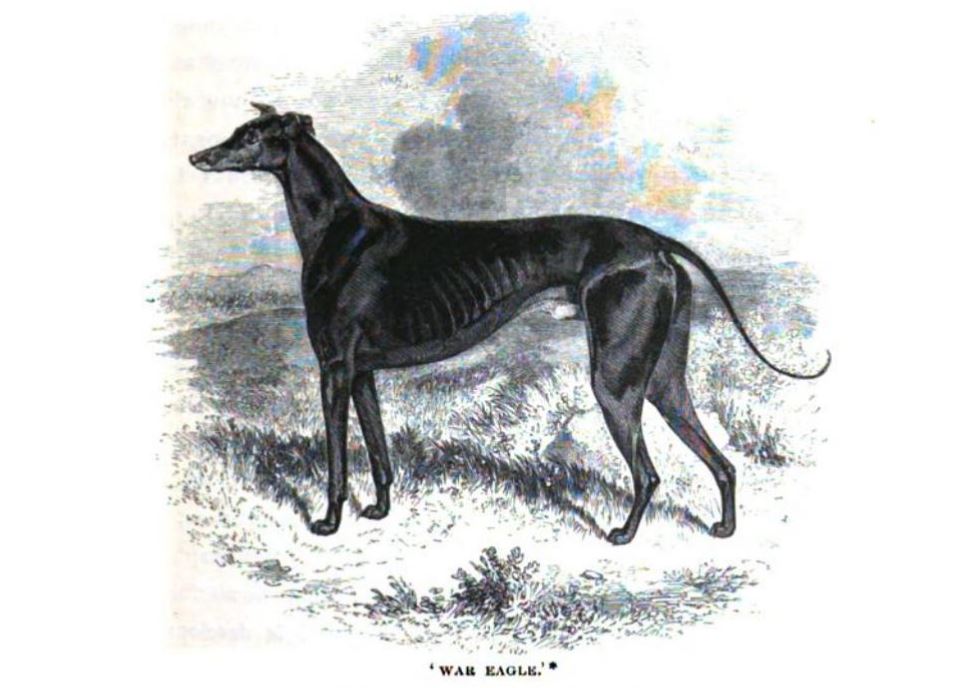Greyhounds, known for their remarkable speed and agility, have been the subject of selective breeding for centuries, particularly in Britain and Ireland. Dating back over two centuries ago, the popularity of hare coursing as a sport led to the meticulous breeding of these dogs.
The modern greyhounds we have today are primarily the result of this selective breeding, which aimed to produce some of the swiftest and most capable coursing dogs possible. Thus, the history of hare coursing and greyhound breeding are inextricably linked and contribute to the impressive attributes of greyhounds we admire today.
Historically, hare coursing involved the pursuit of hares by greyhounds. This sporting activity was divided into two distinctive categories, each governed by its own unique principles. One typology was prevalent in private settings, while the other was observed publicly and was known as “public coursing”.
Historical Perspective on Greyhound Hare Coursing
Hare coursing, or the pursuit of hares using greyhounds, has a rich history with two main forms: private and public coursing. Each had different objectives and approaches based on various cultural views and techniques.
Private Coursing: The Thrill of the Hunt
Private coursing was all about the hunt – the capture and killing of the hare. This was the main goal for those taking part in private coursing. Usually, a maximum of two greyhounds were used at a time, except for some very ambitious individuals, often called “pot hunters”. The ability to hunt efficiently and effectively was highly valued, hence the ideal greyhound was often considered a “good killer”.
However, not everyone was single-minded about the kill. Some coursers, even in private coursing, cared about giving the hare a fair chance to escape and appreciated the various strengths of their greyhounds.
Public Coursing: The Measure of Ability
Public coursing had a different focus, it was not about capturing the hare, but about assessing the ability of the greyhounds. The hare was primarily used as a yardstick. The dogs were not being judged in relation to the hare, but against each other. The hare served more as a test subject for comparing the dogs’ abilities and performance.
Let’s see a comparative glance between these two types of coursing:
| Coursing Type | Primary Objective | Competitors | Number of Dogs Used |
|---|---|---|---|
| Private | Capture of Hare | Dogs vs Hared | Typically two |
| Public | Evaluation of Dogs | Dogs vs Dogs | Varies |
Reflecting on these hare coursing methods provides interesting insights into the strategies and cultural aspects of this traditional sport in the past.
Private Coursing: Challenges
One notable limitation of private coursing was the lack of regular critique. Without a designated judge to evaluate the dogs’ abilities, a dog owner’s potentially biased judgment often overruled an objective appraisal of their dogs.
The act of catching and killing the hare often served as the ultimate test of skill. This indisputable and observable event was commonly bragged about by greyhound owners. However, the focus on this accomplishment often led to overlooking other important skills of the dogs.
Public Coursing: The Competitive Spirit
Contrastingly, public coursing had a different set of conditions and goals. While coursers desired the hare’s death to encourage their greyhound’s bravery and vigor, they also enjoyed the chase and the possibility of a clever hare escaping.
Thanks to established rules and strategies, a common tactic in public coursing was for the competing dogs to alternate in pursuing the hare, which often gave the hare a reasonable chance to escape.
Horse Racing and Hare Coursing: A Comparative Study
Public coursing can be likened to a three-horse race where two horses come from the same stable. One horse takes the lead while the other conserves energy for the final sprint. Despite possible unfairness, this strategy was seen as fine in a race, similar to the tactics used in public coursing.
Here’s a comparison table of the two types of hare coursing:
| Coursing Type | Deficiency | Merit Determinant | Strategy |
|---|---|---|---|
| Private Coursing | Lack of Objective Appraisal | Singular – Capturing and Killing of the Hare | N/A |
| Public Coursing | N/A | Flexible – Overall Performance of the Dogs | Alternating Pursuit of the Hare by Competing Dogs |
Contrasting Agendas: Private vs. Public Coursing
The fundamental difference between private and public coursing was the designation of competitors. In private coursing, the dogs competed against the hare, while in public coursing, the dogs vied against each other. Due to these different objectives and rules, a good private dog might struggle in a public setting.
In public events, sometimes dogs ‘waited’, and this tactic could be helpful in a dog vs. hare encounter but detrimental in a dog vs. dog competition.
Public coursers didn’t judge the best greyhound to be the one that killed the hare, but rather the one that contributed the most to its capture during the course. As a result, crafty strategies were seen as unfavorable as they provided the other dog with opportunities to ‘score points’. This principle often led to a top public dog disappointing a private courser due to differing principles and expectations. For instance, a dog highly valued for its strategical waiting approach in private coursing could be easily beaten by a less cunning, but more active, greyhound in public coursing.
Simplifying the History of Coursing Styles
Historically, coursing has come in two forms: private and public. They’re based on the same principle, but key differences in how they’re executed give them unique characteristics.
Mixing Private and Public Coursing Styles
Typically, they follow different rules, but it wasn’t uncommon to see greyhounds run privately under public coursing rules, providing a similar atmosphere to famous gatherings like the Amesbury or Waterloo meetings. To merge the two styles, you’d need to consider:
Finding a Judge: Judges were a significant addition, not always easy to arrange but held a lot of authority once set up.
Aligning the Rules: Under a judge’s watch, private coursing could mimic public coursing’s intensity. However, without regulated rules, the activity could devolve into simple ‘pot hunting,’ or hunting for food or prizes.
The Appeal of Public Coursing
Public coursing becomes more enjoyable when spectators have an interest in specific dogs competing in the event.
Akin to Horse Racing: Some argue that public coursing can’t match horse racing’s thrill, like the races at Newmarket or Epsom. Yet, enthusiasts believe coursing between two well-bred greyhounds offers more than just the speed factor in horse racing.
Assessment of Traits: The dogs in coursing were judged on several aspects, beyond just speed, such as their ability to work and kill, their mental and physical agility, hardiness, and integrity.
Evaluation Variables
| Area of Interest | Points to be Considered |
|---|---|
| Physical Abilities | Speed, stamina |
| Mental Aptitudes | Assertiveness, competitive spirit, perseverance |
A detailed analysis of greyhounds’ traits commonly emphasized:
Greyhound Temperament: Considerable importance was placed on ‘jealousy’ or the urge to outdo rivals which was seen as undesirable in other hunting dogs like pointers or hounds.
Deception vs. Honesty: In public coursing, any hint of deception, like allowing another greyhound to do most of the work, was frowned upon and dubbed ‘lurching’ or being ‘false’.
Mix of Traits: A successful greyhound needed to have a combination of attributes including racehorse-like speed, strong hunting skills, and a keen mind characterized by hardiness and integrity.
In summary, coursing not only cherished the thrill of the hunt but also the desire to outpace rivals. Greyhounds labeled as ‘false’ often showed a strong run when alone but lost interest when another dog was involved, unless their claim to the prey was challenged.
Understanding the Complexities of Greyhound Breeding
Coursing involves a variety of factors like speed, stamina, and honesty in greyhounds, but combining these traits can be challenging.
Attributes of Coursing Dogs
Coursing dog success depends on several factors:
- Speed: Fast dogs had a different build than dogs with more endurance.
- Stoutness: Smaller, compact greyhounds praised for their stamina and resilience.
- Working abilities: The dog’s ability to chase and capture game.
- Honesty: Putting in genuine effort throughout the chase, regardless of speed or abilities.
Breeding these traits faced unique challenges like:
- Speed vs. Stoutness Balance: It was hard to breed a greyhound with attributes of both speed and endurance.
- Honesty in Fast Dogs: In practice, fast dogs weren’t often as honest as slower dogs.
Greyhound Breeding Intricacies
Successful greyhound breeding relied on understanding the bloodline and form of victorious dogs. While the greyhound’s form is visible, the concept of ‘blood’ remains elusive.
To understand ‘blood’ in greyhound breeding, consider:
- Bloodline in Greyhounds: Thacker tried justifying the blood’s impact on pedigree through blood globule shapes, a now-disputed theory.
- Physiological Traits: Traits like thin skin and dense veins offered advantages during physical exertion, like efficient cooling and blood circulation.
| Trait | Advantage to Greyhound |
|---|---|
| Thin Skin | Rapid body temperature cooling during exertion. |
| Dense network of veins | Efficient blood circulation during a chase. |
- Nervous System and Brain: High-bred dogs had a different brain volume, potentially resulting in increased mental agility and perception.
Blood and Breeding Beyond the Physiology
In coursing circles, the term ‘blood’ extends beyond the physiological, defining a greyhound’s lineage or pedigree.
Two factors differentiating high-bred and lower-quality breeds were:
- Nervous System: High-quality breeds had a more advanced nervous system, possibly contributing to their ability to run until exhaustion or even death.
- Breeding History: Breeding lines provided insights into inherited abilities and traits, with substantial differences in mental capacity and physical strength between different breeds.
The challenge in coursing and greyhound breeding lies in decoding the generations’ impact on breeds while considering the physical and mental attributes they display.
Historical Examination of Greyhound Brain Structures and Behavior
Canine behavior analysis in the 19th century unveiled correlations between brain structures and behavioral traits. This understanding went beyond intellectual faculties related to specific brain areas and encompassed passions tied to other parts of a dog’s brain.
Brain Structures and Behavior Patterns
- Back Brain and Animal Passions: There was a clear association between the posterior part of the brain and dog’s expression of animal passions.
- Bulldog Example: Bulldogs, known for their tenacity, had more extensive brains between their ears, intensifying their animal-driven passions and risk-taking behavior.
- Front Brain and Intellectual Abilities: The anterior part of the brain, or forebrain, majorly influenced a dog’s intellectual faculties.
An enlarged posterior brain development was often seen to overshadow, and even overcome a dog’s attachment to its master, leading to instances where agitated dogs might attack their owner.
Scientists proposed that more developed organs may lead to increased associated functional skills, applicable across different dog breeds, without considering bloodlines or lineage variations.
‘Good Blood’ and the Nervous System
In the 1800s, ‘good blood’ referred to optimal functionality in all dog organs. The path to achieving this heavily relied on brain or nervous system development, demonstrating specific desired qualities in a dog.
It was suggested that a well-bred greyhound needed more developed traits than a racehorse, including agility, robustness, and resistance to injuries. In contrast, a high-grade racehorse required a brain structure enabling clever galloping splits and endurance to maintain the pace.
Greyhound Breeding in History
In coursing, the aim was balancing desired traits. At times, a physically weaker greyhound with ideal qualities could outperform a physically superior but lacking counterpart. This ‘invisible difference,’ known as ‘blood,’ marked a significant variation between similarly built animals, pushing one’s performance beyond the other.
Greyhound Physical Forms: Fast vs. Slow
Unlike racehorses, experts could not easily predict greyhounds’ speed based on their physical form. For instance, ‘War Eagle,’ despite being bulkier than his agile sister ‘Well I Never,’ consistently outperformed her.
Comparing Similar-looking Greyhounds: War Eagle vs. Tendresse
Greyhounds like War Eagle had broad heads, indicating qualities such as resistance to injury. However, these characteristics weren’t always tied to extended heads in other greyhounds of similar breeds. The best judges were those who had seen both War Eagle and Tendresse in action.
Characteristics of Speed, Stamina, and Abilities in Greyhounds
Against common belief, history shows that speed could coexist with working abilities or the intense zeal to attack, separate from stamina. A remarkable example from 1852 showcased a litter from Curler and Lucy demonstrating superb speed, excellent work performance, resilience, and indifference to punishment.
Key Points:
- Physical Form: This was linked with both speed and sturdiness. While a compact, muscular form usually signaled sturdiness, exceptions like ‘War Eagle’ showed high speed despite a bigger physique.
- Brain Development: The descendants of the dog ‘Jason’ had a significant brain development, usually measuring between 14.5 to 15 inches. The combination of extensive brain development and impressive speed debunked the idea of sturdiness being purely related to speed or stamina. Whether this brain form was a bulldog inheritance or a family characteristic remained a controversial topic.
In conclusion, the blend of speed, agility, and endurance in a greyhound was more critical than focusing on one aspect, irrespective of the breed’s habitat. This strategic combination was the secret to optimal performance desired by coursers.




